brakes PONTIAC BONNEVILLE 1996 Owners Manual
[x] Cancel search | Manufacturer: PONTIAC, Model Year: 1996, Model line: BONNEVILLE, Model: PONTIAC BONNEVILLE 1996Pages: 387, PDF Size: 18.71 MB
Page 6 of 387
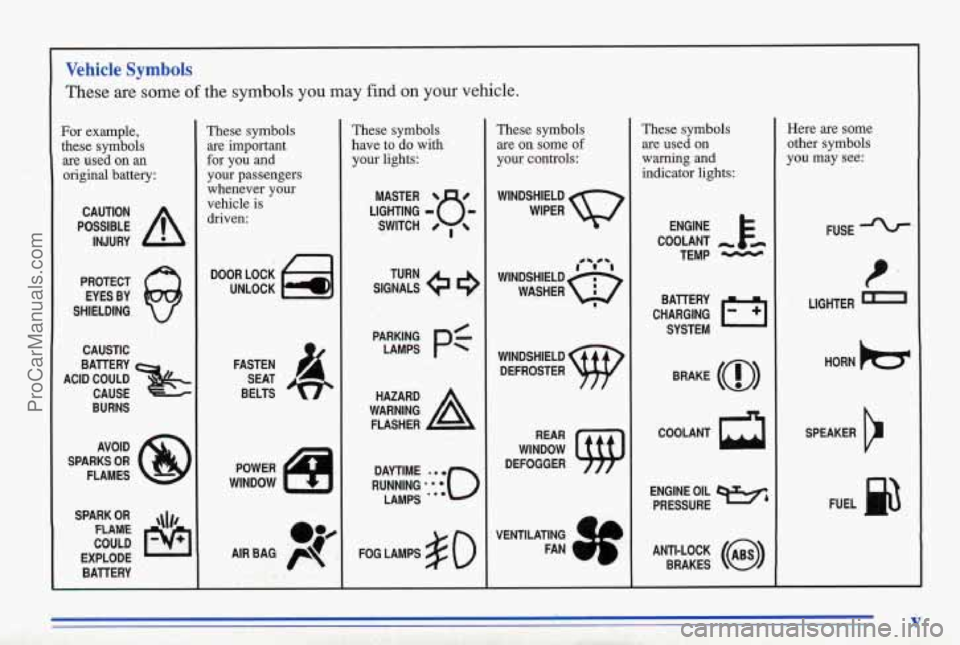
Vehicle Symbols
These are some of the symbols you may find on your vehicle.
For example, these symbols are used on
an
original battery:
POSSIBLE A
CAUTION
INJURY
PROTECT EYES BY
SHIELDING
CAUSTIC
BURNS AVOID
SPARKS
OR
FLAMES
SPARK
OR ,\I/,
COULD
RAM€
EXPLODE BATTERY
These symbols are
important
for you and
your passengers whenever your
vehicle
is
driven:
f-l DOOR LOCK
UNLOCK
FASTEN SEAT
BELTS
e?
AIR BAG p
These symbols
have to do with your lights:
SIGNALS e
TURN
PARKING
p$ LAMPS
FOG LAMPS
$0
These symbols are on some of
your controls:
WIPER Q
WINDSHIELD
DEFROSTER
VENTILATING
FAN - )
These symbols are used on
warning
and
indicator lights:
ENGINE
COOLANT
- e-
TEMP -
CHARGING I-1
BATTERY
SYSTEM
BRAKE
(0)
COOLANT a
ENGINE OIL e,
PRESSURE
ANTI~LOCK (@)
BRAKES
Here are some
other symbols
you
may see:
FUSE
LIGHTER
m
HORN )tr
SPEAKER
b
FUEL p3
v
ProCarManuals.com
Page 73 of 387
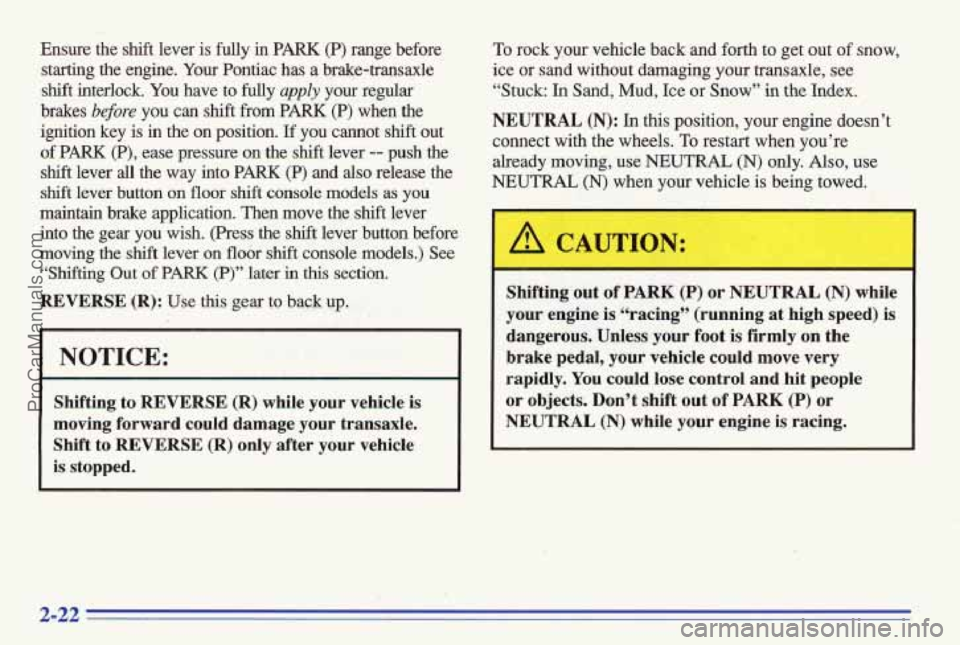
Ensure the shft lever is fully in PARK (P) range before
starting the engine.
Your Pontiac has a brake-transaxle
shift interlock. You have to fully
apply your regular
brakes
before you can shift from PARK (P) when the
ignition key is in the on position.
If you cannot shift out
of PARK (P), ease pressure on the shift lever -- push the
shift lever all the way into PARK (P) and also release the
shift lever button on floor shift console models as you
maintain brake application. Then move the shift lever
into the gear you wish. (Press the
shift lever button before
moving the shift lever on floor shift console models.) See
“Shifting Out of PARK (P)” later in this section.
REVERSE (R): Use this gear to back up.
NOTICE:
Shifting to REVERSE (R) while your vehicle is
moving forward could damage your transaxle.
Shift to REVERSE
(R) only after your vehicle
is stopped. To
rock your vehicle back and forth
to get out of snow,
ice or sand without damaging your transaxle, see
“Stuck:
In Sand, Mud, Ice or Snow” in the Index.
NEUTRAL (N): In this position, your engine doesn’t
connect with
the wheels. To restart when you’re
already moving, use
NEUTRAL (N) only. Also, use
NEUTRAL (N) when your vehicle is being towed.
A CAUTION:
Shifting out of PARK (P) or NEUTRAL (N) while
your engine is “racing” (running at high speed) is
dangerous. Unless your foot is firmly
on the
brake pedal,
your vehicle could move very
rapidly.
You could lose control and hit people
or objects. Don’t shift out of
PARK (P) or
NEUTRAL (N) while your engine is racing.
2-22
ProCarManuals.com
Page 75 of 387
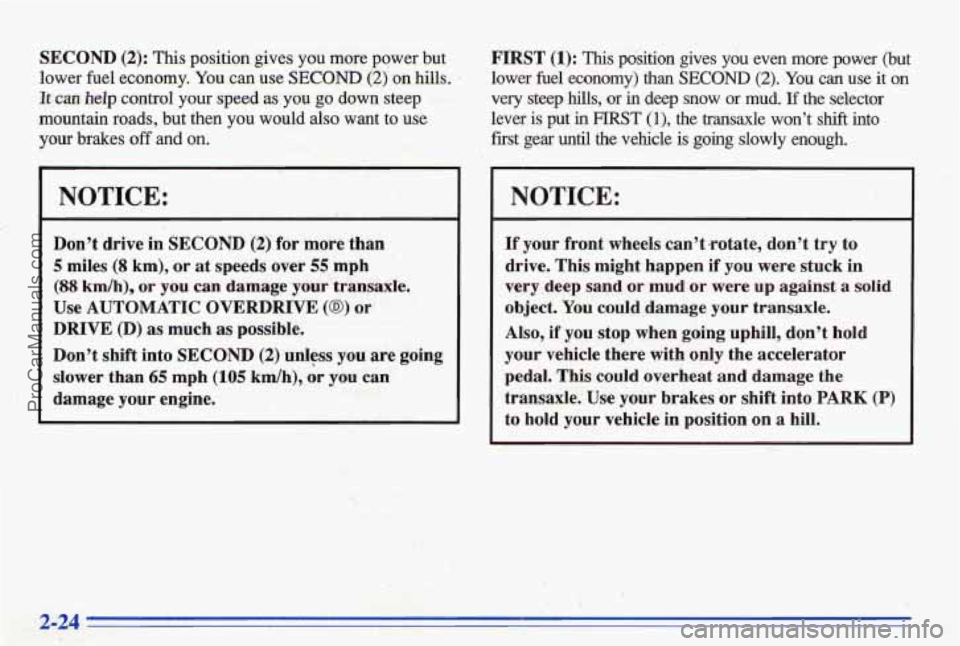
SECOND (2): This position gives you more power but
lower fuel economy.
You can use SECOND (2)-on hills.
It can help control your speed as you go down steep
mountain roads, but then you would also want
to use
your brakes off and on.
~~ ~~
NOTICE:
Don't drive in SEC.OND (2) for more than
5 miles (8 km), or at speeds over 55 mph
(88 kdh), or you can damage your transaxle.
Use
AUTOMATIC OVERDRIVE (0) or
DRIVE (D) as much as possible.
Don't shift into
SECOND (2) unless you are going
slower than 65 mph (105 km/h), dr you can
damage your engine.
%IRST (1): This position gives you even more power (but
lower he1 economy) than
SECOND (2). You can use it on
very steep hills, or in deep snow or mud. If the selector
lever
is put in FIRST (l)? the transaxle won't shift into
first gear until the vehicle is going slowly enough.
~~~~ ~~ ~
NOTICE:
~~ ~ ~~~
If your front wheels can't rotate, don't- try to
drive. This might happen if you were stuck in
very deep sand or mud or were up against a solid
object. You could damage your transaxle.
Also,
if you stop when going uphill, don't hold
your vehicle there with only the accelerator
pedal. .This could overheat
and damage the
transaxle. Use your brakes or shift into PARK (P)
to hold your vehicle in position on a hill.
2-24
ProCarManuals.com
Page 77 of 387
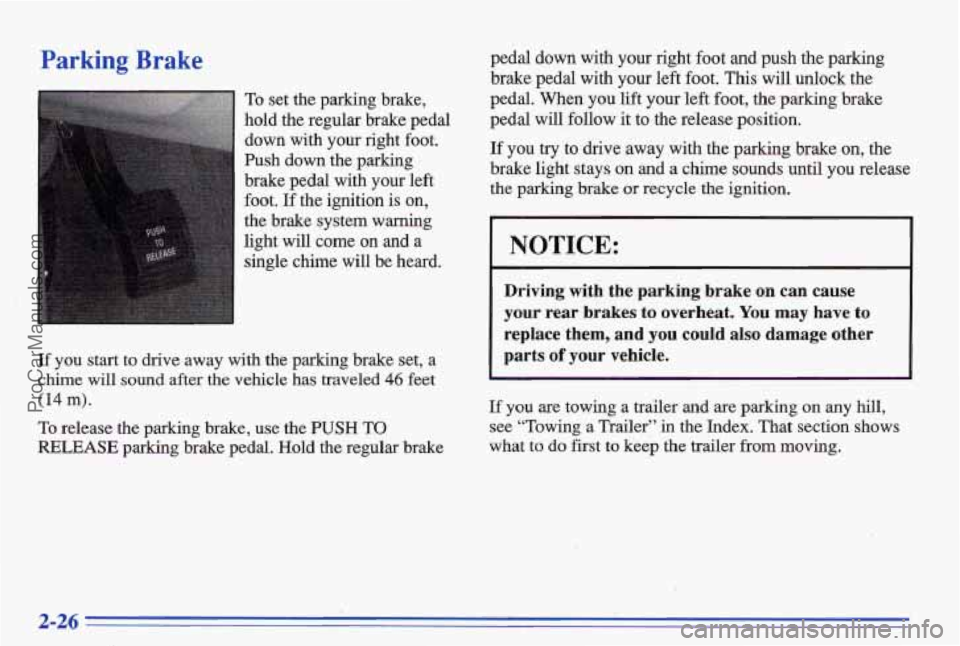
Parking Brake
To set the parking brake,
hold the regular brake pedal down- with
your right foot.
Push down the
parking
brake pedal with your left .
foot. If the ignition is on,
the brake system warning
light will come on
and a
single
chime will be heard.
If you start to drive away with the parking brake set, a
chime will sound after the vehicle has traveled 46 feet
(14
m).
To release the parking brake, use the PUSH TO
RELEASE parking brake pedal. Hold the regular brake pedal down with
your right foot and push the parking
brake pedal with your left foot. This will unlock the
pedal. When you lift your left foot, the parking brake
pedal will
follow it to the release position.
If you try to drive away with the parlung brake on, the
brake light stays
on and a chime sounds until you release
the parking brake or recycle^ the ignition.
I
NOTICE:
Driving with the parking brake on can cause
your rear brakes to overheat.
You may have to
replace them, and you could also damage other
parts
of your vehicle.
If you are towing a trailer and are parking on any hill,
see “Towing a Trailer” in the Index. That section shows
what
to do first to keep the trailer from moving.
2-26
ProCarManuals.com
Page 88 of 387
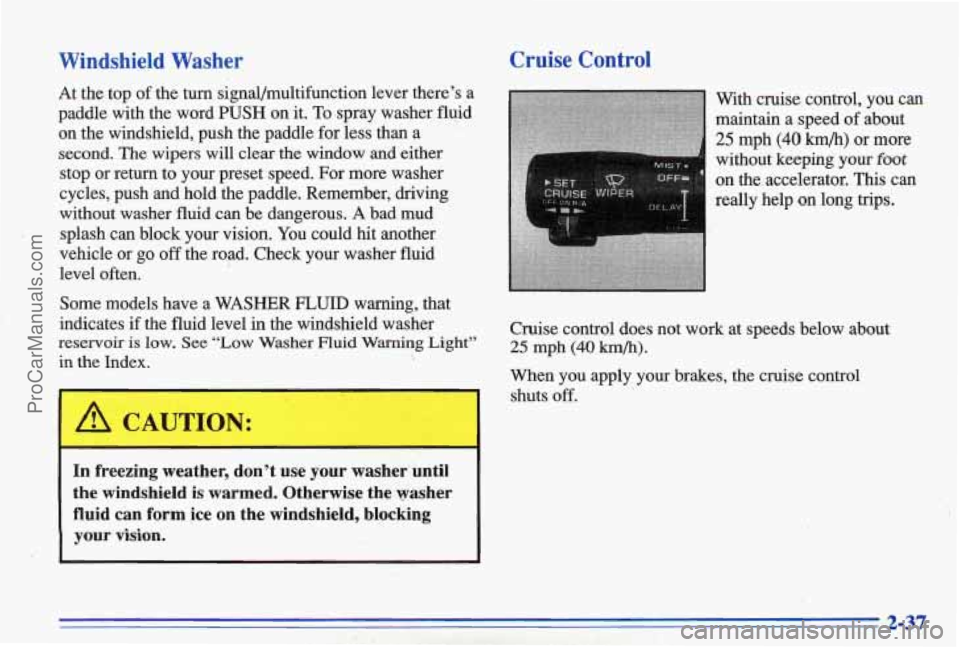
Windshield Washer
At the top of the turn signal/multifunction lever there’s a
paddle with the word
PUSH on it. To spray washer fluid
on the windshield, push the paddle for less than a
second. The wipers
will clear the window and either
stop or return to your preset speed. For more washer
cycles, push and hold the paddle. Remember, driving
without washer fluid can be dangerous.
A bad mud
splash can block your vision. You could hit another
vehicle or go
off the road. Check your washer fluid
level often.
Some models have a WASHER
FLUID warning, that
indicates
if the fluid level in the windshield washer
reservoir is low. See “Low Washer Fluid Warning Light”
in
the Index.
A CAUTION:
In freezing weather, don’t use your washer until
the windshield is warmed. Otherwise the washer fluid can form ice on the windshield, blocking
your vision.
Cruise Control
on the accelerator. his can
really help
on long trips.
Cruise control does not work at speeds below about
25 mph (40 km/h).
When you apply your brakes, the cruise control
shuts
off.
ProCarManuals.com
Page 117 of 387
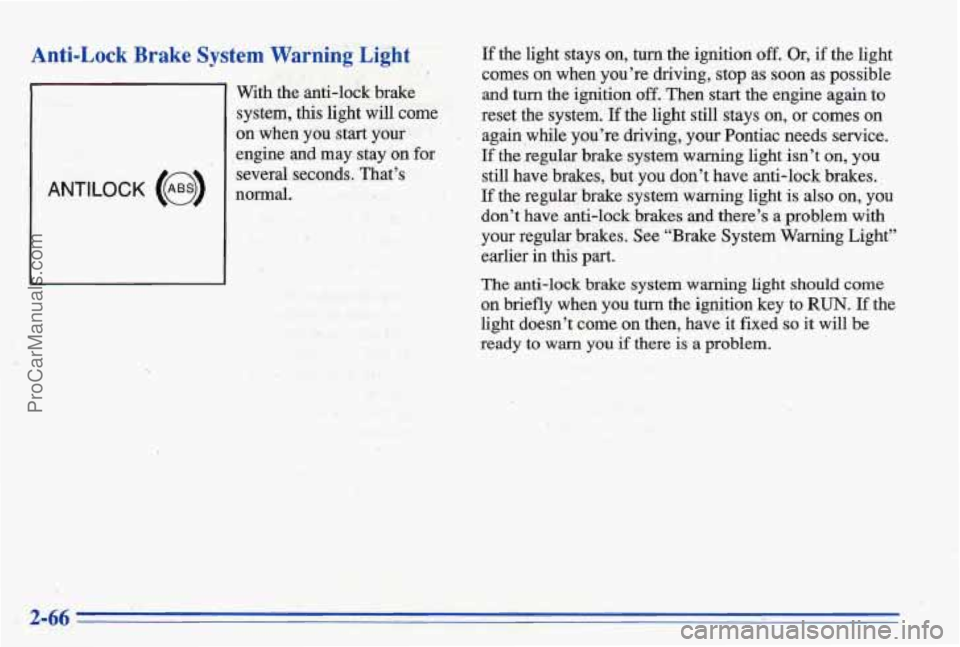
Anti-Lock Brake System Warhing Light If the light stays on, turn the ignition off. Or, if the light I comes on when you’re driving, stop as soon as possible
With the anti-lock
brake and turn the ignition off. Then start the engine again to
system, &is fight will come reset the system. If the light still stays on, or comes on
ANTILOCK (@)
1
on when you start your I again while you’re driving, your Pontiac needs service.
,engine
and may stay on for If the regular brake system warning light isn’t on, you
several seconds. That’s still have brakes, but YOU don’t have anti-lock brakes.
normal.
If the regular brake system warning light is’ also on, YOU
don’t have anti-lock brakes and there’s a problem with
your regular brakes. See “Brake System Warning Light”
earlier
in this part.
The anti-lock brake system warning light should come
on briefly when you turn the ignition key to RUN. If the
light doesn’t
come on then, have‘it fixed so it will be
ready
to warn you if there is a problem.
ProCarManuals.com
Page 118 of 387
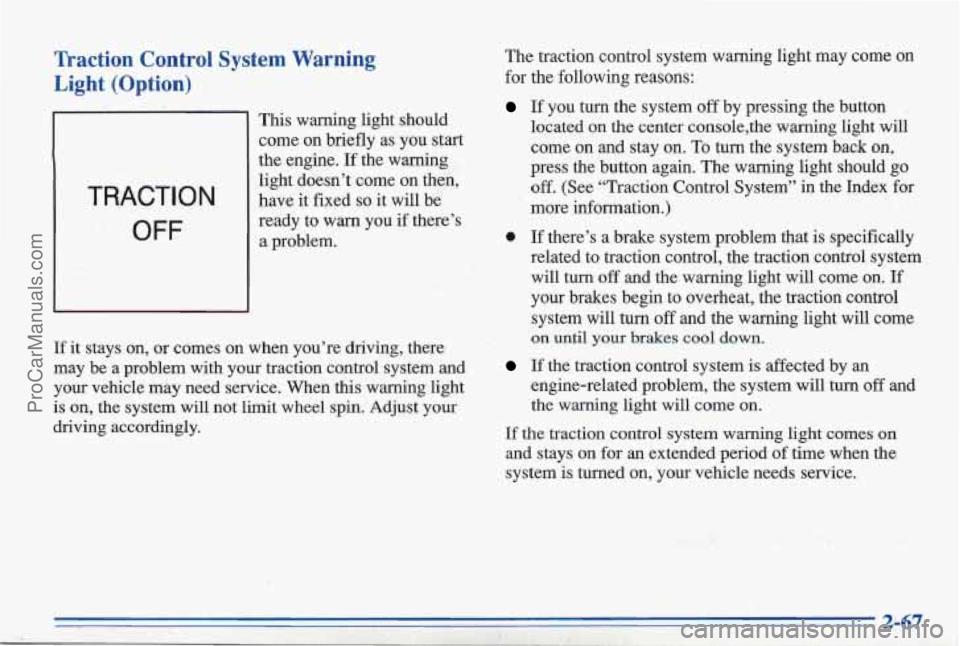
Traction Control System Warning Light (Option)
TRACTION
OFF
This warning light should
come on briefly as you start
the engine.
If the warning
light doesn’t come on then,
have it fixed
so it will be
ready to warn you
if there’s
a problem.
If it stays on, or comes on when you’re mvmg, there
may be a problem with your traction control system and
your vehicle may need service. When this warning light
is
on, the system will not limit wheel spin. Adjust your
driving accordingly. The
traction control system warning light may come on
for the following reasons:
If you turn the system off by pressing the button
located
on the center console,the warning light will
come on and stay
on. To turn the system back on,
press the button again. The warning light should go
off. (See “Traction Control System” in the Index for
more information.)
related to traction control, the traction control system will turn off and the warning light will come on.
If
your brakes begin to overheat, the traction control
system will turn
off and the warning light will come
an until your brakes cool down.
0 If there’s a brake system problem that is specifically
If the traction control system is affected by an
engine-related problem, the system will
turn off and
the warning light
will come on.
If the traction control system warning light
comes on
and stays on for an extended period of time when the
system is turned on, your vehicle needs service.
ProCarManuals.com
Page 172 of 387
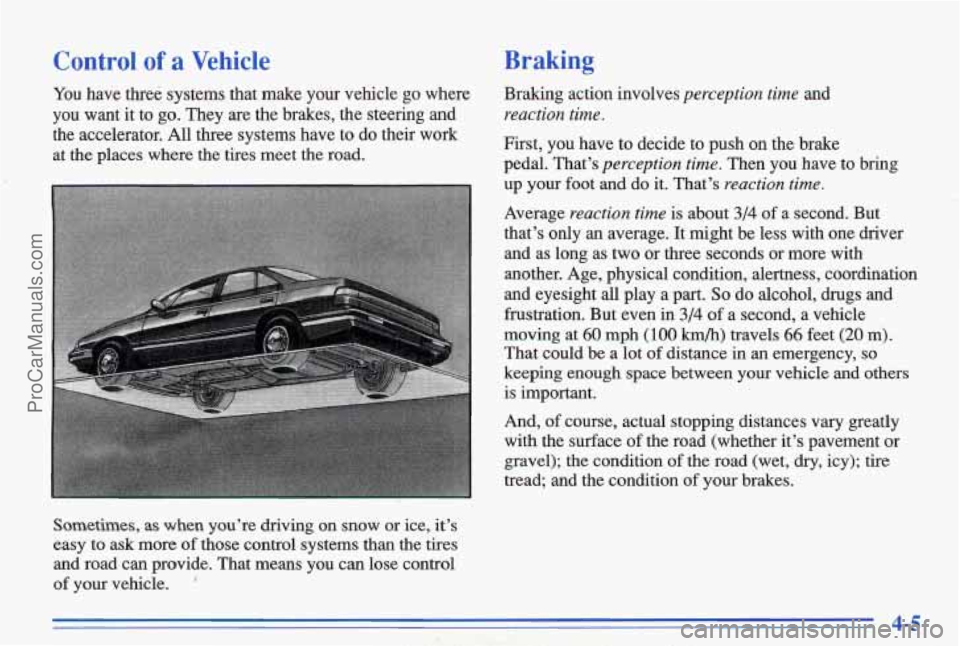
Control of a Vehicle Braking
You have three systems that make your vehicle go where Braking action involves perception
time and
you want it to
go. They are the brakes, the steering and reaction time.
the accelerator. All three systems have to do their work First, you have to decide to push on the brake
at the places where the tires meet the road. pedal. That’s
perception time. Then you have to bring
up your foot Ad do it. That’s
reaction time.
Average reaction time is about 3/4 of a second. But
that’s only an average.
It might be less with one driver
and as long as two or three seconds or more with
another. Age, physical condition, alertness, coordination
and eyesight
all play a part. So do alcohol, drugs and
frustration. But even in
3/4 of a second, a vehicle
moving at
60 mph (100 h/h) travels 66 feet (20 m).
That could be a lot of distance in an emergency,
so
keeping enough space between your vehicle and others
is important.
-
And, of course, actual stopping distances vary greatly
with the surface of the road (whether it’s pavement or
gravel); the condition
of the road (wet, dry, icy); tire
tread; and the condition of your brakes.
Sometimes, as when you’re driving on snow or ice, it’s
easy to ask more
of those control systems than the tires
and road can provide. That means you can lose control
of your vehicle. i
ProCarManuals.com
Page 173 of 387
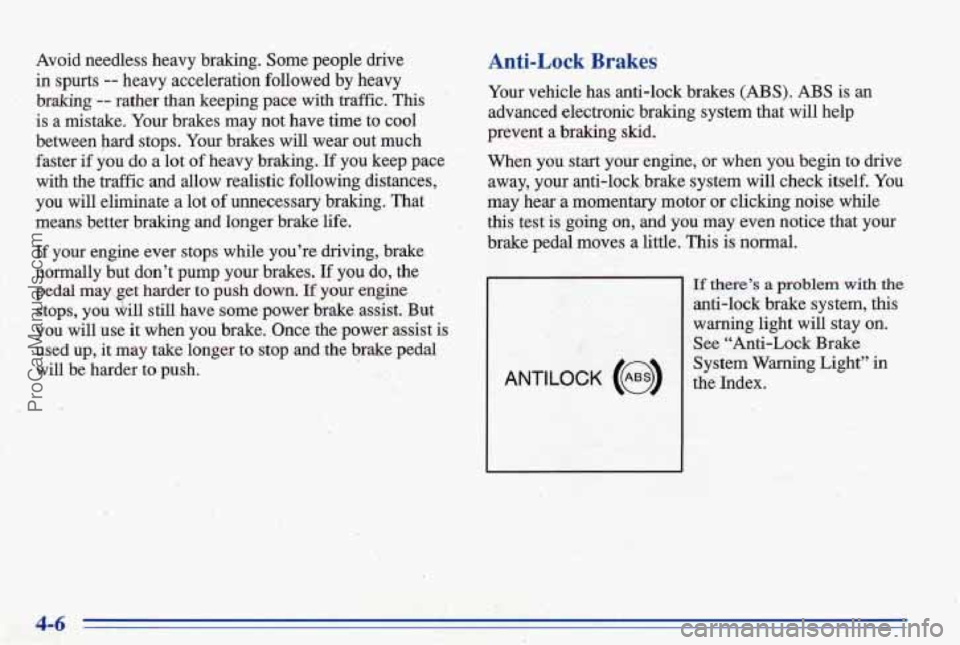
Avoid needless heavy braking. Some people drive
in spurts -- heavy acceleration followed by heavy
braking
-- rather than keeping pace with traffic. This
is a mistake. Your brakes may not have time to cool
between
hard stops. Your brakes will wear out much
faster if you
do a lot of heavy braking. If you keep pace
with the traffic and allow realistic following distances,
you will eliminate
a lot of unnecessary braking. That
means better braking
and longer brake life.
If your engine ever stops while you’re driving, brake
normally but don’t pump your brakes. If you do, the
pedal may
get harder to push down. If your engine -
stops, you dill still have some power brake assist. But
you
will use it when you brake. Once the power assist is
used up,
it may take longer to stop and the brake pedal
will be harder tol push.
Anti-Lock Brakes
Your vehicle has anti-lock brakes (ABS). ABS is an
advanced electronic braking system that will help
prevent
a braking skid.
When you start your engine, or when you begin to drive
away, your anti-lock, brake system
will check itself. You
may hear a momentary motor or clicking noise while
this test is
going on, and you may even notice that your
brake pedal moves
a little. This is normal.
ANTILOCK (a)
If there’s a problem with the
anti-lock brake system, this
warning light will stay on.
See “Anti-Lock Brake
System
Warning Light” in
the Index.
4-6
ProCarManuals.com
Page 174 of 387
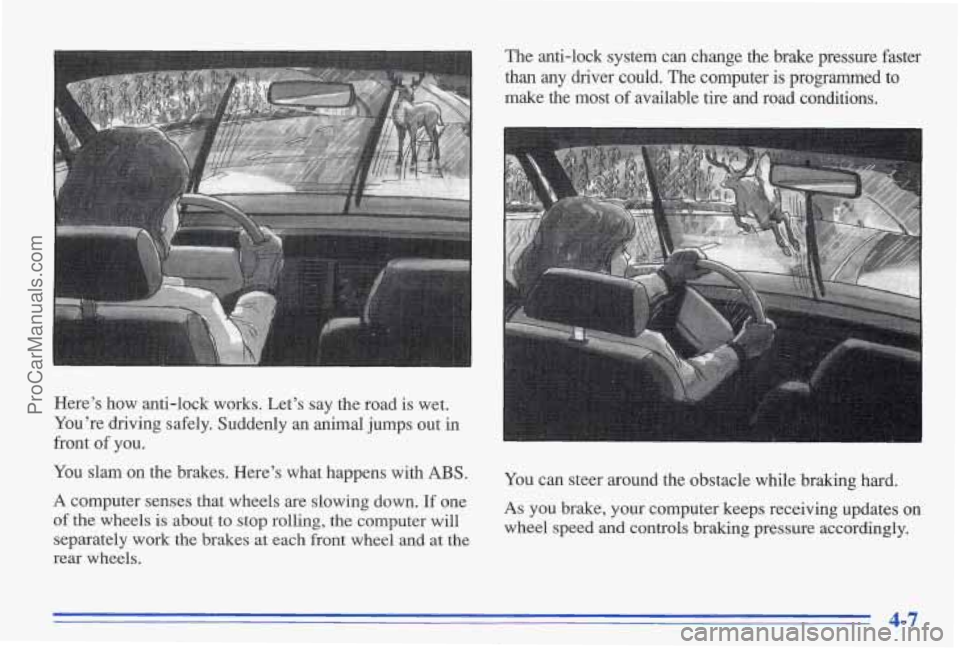
Here’s how anti-lock works. Let’s say the road is wet.
You’re driving safely. Suddenly
an animal jumps out in
front
of you.
You slam on the brakes. Here’s what happens with
ABS.
A computer senses that wheels are slowing down. If one
of the wheels is about to stop rolling, the computer will
separately work the brakes
at each front wheel and at the
rear wheels. The anti-lock system can change the brake pressure faster
than
any driver could. The computer is programmed to
make the most of available tire and road conditions.
You can steer around the obstacle while braking hard.
As you brake, your computer keeps receiving updates on
wheel speed and controls braking pressure accordingly.
ProCarManuals.com